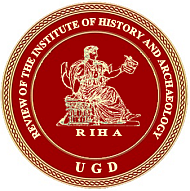TRAVELING BROKERS OF LEGITIMACY - THE SHARED PROTO-HISTORY OF CLASSICAL ARCHAEOLOGY AND MODERN DIPLOMACY IN EARLY MODERN EUROPE
Abstract
'Time threatens to destroy this inimitable work. This we prevent through our efforts. But, o most high king, open to us a mansion which time does not reach.'
These are the words of the inscription from the northern tympanum of St. Sophia - the symbol of stability, technical ingenuity, continuity with the artistic excellence of the classical times and religious authority of Constantinople and Byzantium. But, even more symbolic is the effort of the prominent renaissance traveler, diplomat and antiquarian, Cyriacus of Ancona, to copy this notion in the decades before the fall of Constantinople, the city that served as central authority and fountain of knowledge for the Medieval Europeans for centuries.
In the pre-renaissance period numerous Western Europeans traveled through the Mediterranean and, later on, through Central and South East Europe towards the 'fountain of knowledge' - Byzantium and the wider Eastern Mediterranean. Most of these voyages were linked to economic interests and endeavors, but there were also immense number of those initiated or resulting in additional or separate spiritual, artistic or even scientific interest.
During the early Renaissance, and even after the fall of Constantinople, the voyages continued, and the famous travelers brought back materials, contacts, knowledge and most of all ideas. Some of the famous renaissance travelers we call today early modern diplomats, others master merchants or explorers, first antiquarians or promoters of the arts and the classical past. Only few of the well-known are promoted for what many of these renaissance travelers really were - polymaths wearing several important hats.
This chapter takes a new holistic approach, explaining the crucial role that these outstanding travelers, together with their enthusiastic story-telling and exposing the wonders of the 'classical world' and the 'orient', played in early modernity. I propose that their quest for the antiquity was connected, inspired and highly instrumental in inventing, building and legitimizing the political, military, artistic and religious system and culture of Early Modern Europe.
The chapter aims to expose the true nature of their endeavors, and the impact of their voyages and storytelling on the modern and contemporary European identities.
Key words:
Renaissance, Classical Archaeology, Classical tradition, Renaissance men, Byzantium


